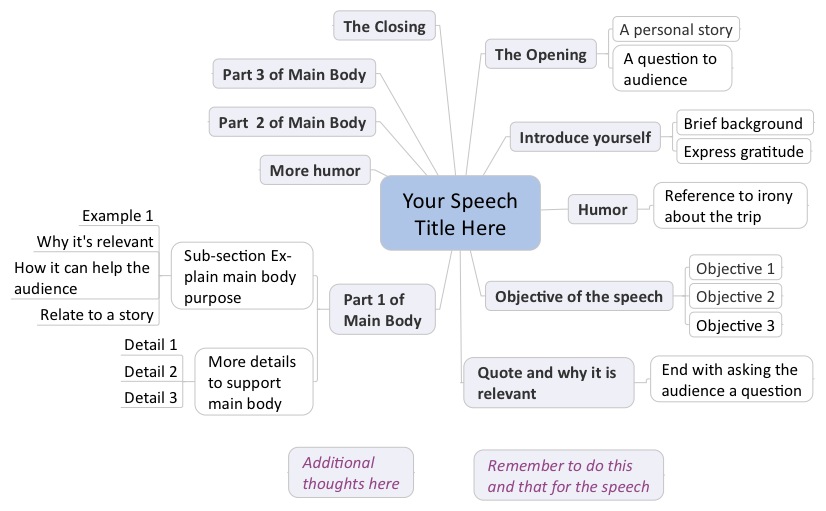 For the last 3 weeks, I have focused on little else other than the upcoming speech at Blogworld. It was an honor to be accepted, after submitting this video proposal. As with all things, however, after the excitement calms down and the dust settles, you are left with real work to do and in this case, I was looking at an hour-long speech to write and deliver. Even with the experience of Toastmasters (video proof!) and a few other public speaking events, the idea of writing for and speaking at Blogworld has been pushing me to break new boundaries in speech preparation.
For the last 3 weeks, I have focused on little else other than the upcoming speech at Blogworld. It was an honor to be accepted, after submitting this video proposal. As with all things, however, after the excitement calms down and the dust settles, you are left with real work to do and in this case, I was looking at an hour-long speech to write and deliver. Even with the experience of Toastmasters (video proof!) and a few other public speaking events, the idea of writing for and speaking at Blogworld has been pushing me to break new boundaries in speech preparation.
“There are only two types of speakers in the world, the nervous and the liar. ”
– Mark Twain
So there, you have it, there’s no point lying about it: I am nervous. The good news is that my nervousness pales in comparison to my excitement. I am determined to share my message and my stories in the most unforgettable, useful and effective way with my audience on the morning of Thursday, May 26th. This much I know.
One day, you will have a chance to speak to a group of people. I urge you not to turn it down even if you are terrified of public speaking. Read what I wrote on the Irrational Fear of Public Speaking last year and think about what an incredible opportunity it would be for exposure and spreading of your message. Say yes to the opportunity!
After countless hours refining the process of speech writing and practicing, I feel compelled to share the highlights with you. Here are my 17 effective tips on speech writing and preparation:
- Know Your Main Motive for Speaking: Why are you speaking? There is always one compelling reason above all others. It’s best to know that in advance. Do you want to share a message? Do you want to influence opinion? Do you want to solve a problem? Do you want name and brand recognition? Do you want to practice your public speaking skills? Lock in on your main motive, be honest with yourself and then align the rest of your speech to it.
- Understand the Requirements and the Audience: This comes from the venue where you will be speaking. If it is a conference, the organizers will provide this information for you. You need to know who is in your audience, what are their interests and desires, and to what type of messaging they best respond. Also, find out the length of the speech, any information about the audience, the preferred methods of delivery (if any) and make sure that your delivery style and your message will be welcomed and well received.
- Decide on Your Overall Message: Your audience will walk away with this. It has to be crystal clear. There should be no doubt at the end of your speech about your overall message and if the audience forgets everything else you said, if they remember this overarching message, you will have done your job well.
- Record Your Ideas: Now that you know your core message for the speech, you can start building the speech. The easiest way to start this is to record your flow of ideas, stories, and thoughts into your Smart Phone or a small audio recorder when you are on the go. Start this preparation phase of your speech at least 3-4 weeks prior to your date. Then transcribe your recording on a word document in no particular order. Now you have some content.
- Create the Speech Outline: The speech outline is the bare bones of your speech; it is the body without the clothes or was that too naughty? You know what I mean. It is the foundation of your speech, the high-level components of the speech. How is the talk going to go? Go over it in your mind. It could go something like this: You open with a great story, then you could inject some humor, maybe a delayed introduction, then you state the main objective, and next you impart your experience as it relates to the core message for building some credibility with your listeners, and then you move on to cover the main sections that support your overall message, then you finish with a powerful closing. This is just an example and you can vary it up as you please. This would also be a good time to gather some quick feedback. Does the general layout of your outline make sense to a close friend or a peer?
- Write the Speech Sections: Now you create the heart of your speech and put the details of each section in your outline above. These are the knowledge, expertise, belief and ideas that compel you to talk on this topic. It does not have to be perfect just yet – it will likely change many times – but you do need to make sure your content in each section is relevant to your core message, that it supports your overall purpose and goal of the speech, and that the order in which you present the ideas is logical and intuitive to your audience. Always, always remember to put yourself in your listener’s shoes. Assume they know little about the topic and consider you the expert who will give them the most in the shortest amount of time.
- Use a Visual Map to Create the Speech: You can do the steps 5 and 6 above by using a word document and stop there. However, I highly encourage you to draw it out using a visual map such as Mindjet Manager (not an affiliate link!). When I put my speech in a visual context, I remember it better when I recite it later because in my mind, I go over the different parts of the map and check them off (or is that just some quirkiness about me?). Seriously, mind maps rock. The greatest reason is this: they add hierarchy to the thoughts and it helps your mind organize them better and remember them easier. Major thought #1 followed with sub-thought 1, then sub-sub-thoughts 1 through 3; then major thought #2, repeat the cycle. See below the sample one I created for you. (Click to expand image)

- Build Good Stuff into Your Speech: So how do you write the actual content? You can use a powerful combination of strong points, supporting material, proof and evidence if need be, personal experience, stories, quotes, social proof and humor (preferably, the self-deprecating kind!). When you vary up the content of the speech in this way, it actually makes it easier to memorize and remember. This is of course just the content that you build into the speech; that’s just half the story. The other half is in the effective delivery. Keep reading.
- Review Your Speech: By now you have your outline, which is all dressed up (see, I was going to put on clothes eventually!), with all the sections and details and ideally, a visual map. Now, you review it over and over and again and again. You read it to yourself, read it out loud, read the high level sections first to know the order then read the whole thing and make sure it flows and does not go dull or weak half way in the middle. If it does, re-write the weak section.
- Determine Your Delivery Style: Your style is unique to you and that is a major bonus you bring to the table as a speaker. Define your style both in terms of delivering the speech and in your use of visual aid and presentation slides. For instance, I chose to go without PowerPoint slides for Blogworld because I believe Power Point and all its logistics limit me as a speaker and take away from my full focus and attention on the audience. Your style may very well include slides or creative visual aid. Define your style and stay loyal to it. You want to leave a lasting impression on your audience with your style.
- Practice Your Speech: I would say to think of your speech in chunks at first. Maybe divide it into 3 or 4 main chunks. Practice each chunk separately. Feel confident about it. Time it and make sure that it fits within your speech requirements. Do this several times. Build confidence and practice over the course of at least 2 weeks to really gain mastery of your speech, especially if the speech is over 30 minutes long.
- Record Yourself on Audio and Listen: You may be self-conscious, or shy or have a grand excuse not to record your own voice. Too bad! I urge you to set those feelings aside, deal with them later, and just record yourself as you recite your speech on your favorite recorder and then listen to yourself. See what you like and what you do not like. Repeat until you feel good about the overall message
- Record Yourself on Video and Watch: When you are ready to record yourself on video, make sure to get dressed up, and pretend this is the event. In fact, create a mental stage, stick to the size of your stage and decide exactly where your imaginary audience is sitting. Then give the speech and watch yourself on video later. Make sure you like how you come across. Watch your gestures and your eye contact and your pacing. Exude confidence. Practice a lot.
- Memorize Your Opening and Ending: This may sound radical but it comes from years of Toastmasters training: Memorize your opening and your ending, if need be, word for word, pause for pause. When you captivate your audience with a great opening, you have their attention for a while. Furthermore, you have a chance to redeem yourself at the very end with a killer closing if you have stumbled or lost them along the way. And if you haven’t, you can still use a great closing. Everyone can. So just memorize these two puppies. No questions asked. You’ll thank me about this one someday!
- Give the Speech to Family or Friends: Preferably, I recommend giving the speech at a Toastmasters club if you belong to one and if the length is sufficient to meet with your club standards. If not, as a family member or a friend to sit through the whole speech and pretend that you are indeed at the event and they are indeed your audience. It does not matter how badly you mess up. It is show time and there is no restarting. Go through it and recover and push through. If you take your rehearsals as seriously as this, the speech will be fun when you are up on the stage.
- Prepare Your Slides or Speaker Notes: If you are preparing slides, I beg you to not go the corporate route and cram it with text or images. In fact, guess who killed Power Point for me? Yep! Corporate America again! Anyway just put 2 or maximum 3 thoughts on one slide. Remember your audience is not there to read but to listen. Since I am going without slides, I will have speaking notes with me. I don’t care for note cards so instead, I am using just standard printed paper with large font outlining the high level sections to cue me in as to what is next. Be sure to practice with the same notes and slides before the big day.
- Choose a Mantra: A mantra in yoga is a thought, a notion, a good phrase that you repeat over and over to yourself until you believe it. It is natural to be nervous before the speech but you need a grand reason to push through. What is your compelling reason to deliver a smashing speech? Repeat it to yourself. Maybe it is to show that you can do it or that your message can have a chance to be heart. Repeat the words over and over. Chase away those seeds of doubt and those drops of nervous sweat and worry. Fill your mind with positive thoughts and self-confidence. If you have practiced and prepared, you are ready.
So as I continue to decide how to decorate my new home office, I prepare for this greatest speech that I intend to give in New York next week. Perhaps, I will get to see you on May 26th, 11:30am Thursday but if not, send me your good vibes and energy. I know you’ll be there with me one way or another.
Well, I have a lot more tips but this post has gone on long enough. If you want more on speech writing and delivery, book me for a session. I’ll help you write your greatest speech yet. Because that’s exactly what I plan to deliver next week, my greatest speech yet!
Gosh, I’m exhausted. Your turn now! I’d love to hear if you have given speeches in public before and what tips you can dispense on effective speech writing and delivery?

 I am Farnoosh, the founder of Prolific Living. So glad you are here. My mission is to empower you to unblock your creative genius to live your dream life.
I am Farnoosh, the founder of Prolific Living. So glad you are here. My mission is to empower you to unblock your creative genius to live your dream life.